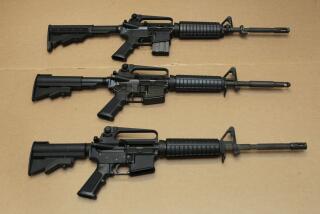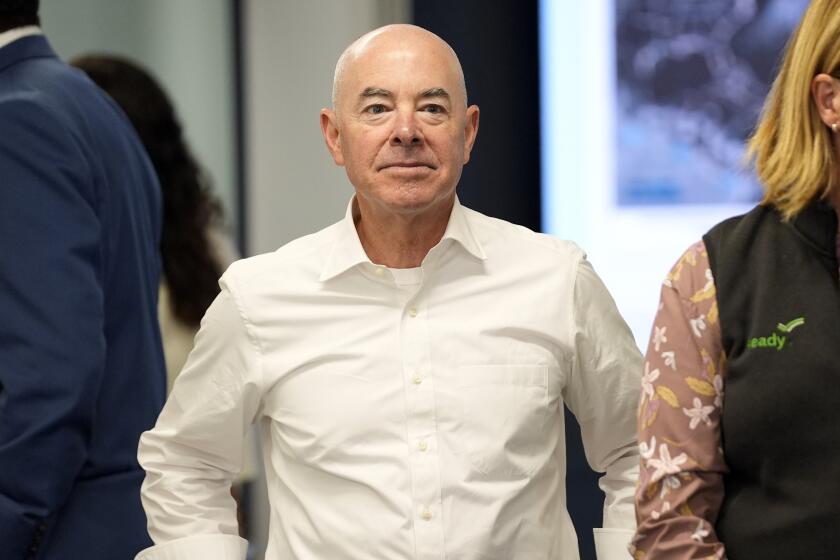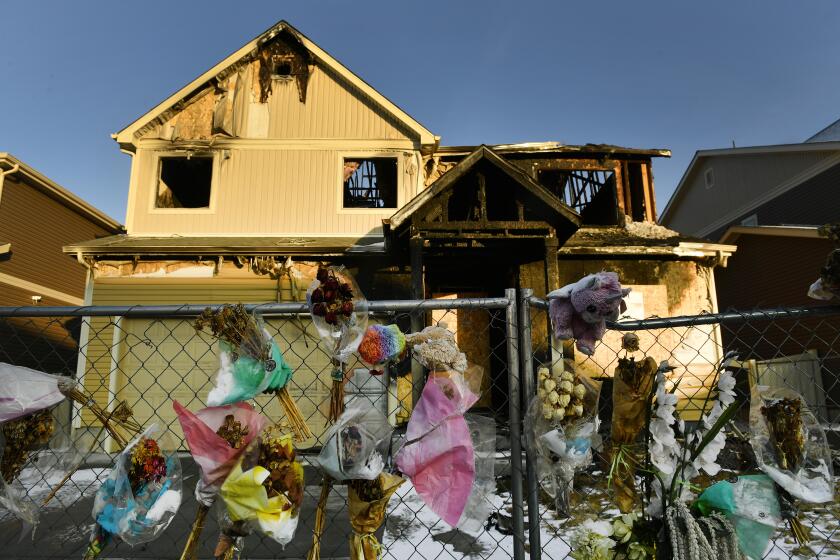Arson at Churches Sparks New Rights Movement
All across the South, churches that were destroyed in last year’s wave of arsons are being rebuilt with multiracial financial and physical support. But here in South Carolina, the only state where white supremacists are known to have conspired to burn black churches and where more sanctuaries were burned than anywhere else, religious and civil rights leaders say rebuilding is not enough.
The leaders are planning a number of initiatives--including a national “march for solidarity” next week and the unveiling of a monument to burned churches--through which they hope to combat racial problems, which they say fester even as the hammers ring out on the new timbers of rebuilding chapels.
“It is imperative that Americans stand up together to challenge hate,” said the Rev. Terrance G. Mackey, whose rural African Methodist Episcopal church was among those burned by members of the Ku Klux Klan in what federal authorities say was a plot to foment a race war. “It’s time for people of goodwill across the country to stand up.”
But while Mackey’s effort enjoys the support of several national organizations and some local white people, it faces twin handicaps: a controversy over whether there really was a nationwide racist conspiracy in the arsons, and the increasingly divisive politics of race in the state.
Republican Gov. David Beasley’s proposal in November to ease tensions by removing the Confederate battle flag from atop the statehouse has already run into trouble.
Many African Americans see the flag as a reminder of slavery. They want it taken down, but many object to Beasley’s plan to move it to a different site on the capitol grounds. Many whites, however, dug in their heels, viewing any plan to move the flag as an attack on their heritage. Blood was shed over the issue last October. Shortly before Beasley went on statewide television to make his proposal, heavily armed Ku Klux Klan members were arrested and charged with firing into a crowd of black teenagers in Pelion, S.C., after attending a pro-flag rally.
The issue is being put to referendum, which ensures that the angry debate will continue full-bore at least until November, when the vote will be held.
*
Even so, the church arsons have been a galvanizing force that brought people together who normally did not talk to one another. Inspired by the arsons, about 500 black and white religious leaders encircled the capitol in January to pray for racial reconciliation and for the removal of the rebel flag.
And newly formed coalitions are committed to tackling problems such as educational inequity, literacy, voter registration and drugs, said Mackey. An umbrella organization, the South Carolina Committee for Racial Justice, will hold forums throughout the state this year to determine what problems should be tackled, said the Rev. Leo Woodbury, a Baptist minister who is helping to coordinate the march.
“The American people have made an incredible response financially to the church burnings,” said the Rev. John Hurst Adams, national bishop of the African Methodist Episcopal Church and a South Carolinian. “They have contributed significant monies to the rebuilding of the buildings. However, it is equally as important, perhaps more important, that America confront the issues behind the burnings.”
Although organizers won’t say how many people they expect to participate in the march, which will take place in Columbia on April 12, they speak of it as an effort to use the issue of the church arsons to force the nation to confront race.
Some have questioned, however, whether some march organizers are making their case by overstating the role of racist hate groups in the fires.
The Atlanta-based Center for Democratic Renewal, which is helping to coordinate the march, contends in a report issued last month that “the conspiracy to start a race war is the driving force behind attacks on black churches.”
The contention by the center, which monitors racial hate groups and engages in grass-roots organizing, goes far beyond the findings of government investigators and other groups.
Analyzing archival data, the report says that this is the fourth wave of church arsons since the 1860s and that each wave has coincided with the rise of the Ku Klux Klan and other white supremacist groups.
The center identifies the first wave as occurring during Reconstruction following the Civil War; the second was in the 1920s when the klan reemerged; the third was during the backlash to the civil rights movement of the 1950s; and the fourth and current wave began in the late 1980s.
While acknowledging the lack of concrete evidence linking the arsonists in this latest wave of church burnings, the report argues that klan members in South Carolina who have confessed to starting fires are tied to neo-Nazis in other parts of the country. The klan and neo-Nazis both draw on the ideology of the racist Christian Identity Movement, which espouses violence against black people, Jews and race-mixers, the report contends.
*
“The difference between our organization and others is that we take them [white supremacists] at their word,” said Rose Williams, national program director of the center.
Morris Dees, head of a legal aid and watchdog organization, the Alabama-based Southern Poverty Law Center, called the allegation of a national conspiracy irresponsible.
Dees’ group is suing the klan in South Carolina on behalf of the burned churches for engaging in a conspiracy to destroy places of worship. The government contends that local klan members waged a mini-reign of terror, including arsons, beatings and stabbings--all in an attempt to start a race war.
But Dees said, “I don’t see any evidence and I don’t believe any exists that there was a [national] conspiracy in the legal definition . . . to burn white or black churches in the United States.”
Conceding that there was a limited conspiracy in South Carolina and probably in Louisiana, Tennessee and Alabama--where two or more churches were burned in close proximity within a short period of time--Dees disputed that there was any national coordination.
*
Federal authorities have investigated more than 350 church fires since the start of 1995. Roughly an equal number of black and white churches in the South have been burned, and the government reported in January that of the arsonists arrested since 1995 for burning black churches, 35 were white and 17 were black. Conspiracy charges were filed in only two church arsons, both set by the same group of South Carolina klansmen.
Four members of the Clarendon County, S.C., chapter of the Christian Knights of the Ku Klux Klan have pleaded guilty to setting fires.
Dees contends that the vast majority of arsonists are individual racists, small informal groups, teenage vandals or pyromaniacs. Only an “extreme leftist group” would contend otherwise, he said.
But Tom Turnipseed, press secretary in the 1960s for Alabama Gov. George C. Wallace and a founder of the Centers for Democratic Renewal, said evidence of a national racist conspiracy to sow terror “is as plain as the nose on your face.”
According to data collected by the Center for Democratic Renewal, more than 200 black and multiracial churches have been burned since 1990, with most of the fires being set since the beginning of 1996.
The center, which says the fires affected more than 20,000 people and caused more than $25 million in property damage, says South Carolina had 33 church fires, more than any other state.
More to Read
Start your day right
Sign up for Essential California for news, features and recommendations from the L.A. Times and beyond in your inbox six days a week.
You may occasionally receive promotional content from the Los Angeles Times.






